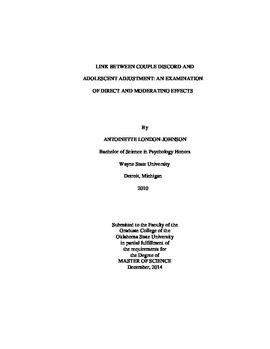| dc.contributor.advisor | Morris, Amanda Sheffield | |
| dc.contributor.author | London-Johnson, Antoinette Marie | |
| dc.date.accessioned | 2016-01-20T15:44:41Z | |
| dc.date.available | 2016-01-20T15:44:41Z | |
| dc.date.issued | 2014-12-01 | |
| dc.identifier.uri | https://hdl.handle.net/11244/25674 | |
| dc.description.abstract | Abstract The purpose of this study was to examine the link between couple discord and adolescent adjustment (i.e. antisocial behavior, prosocial behavior, depressive symptoms, school grades) and whether this link was moderated by parent-youth relationship quality, adolescent emotion regulation, and adolescent gender. The sample consisted of 145 families with adolescents who participated in the Family Youth and Development Project. The results indicate that high levels of couple discord was significantly related to poorer school grades. The findings also indicate that couple discord was positively and significantly related to antisocial behavior under low levels of parent-youth relationship quality. In addition, there were significant couple discord X youth sex interactions in the prediction of antisocial behavior. Likewise, adolescent emotion regulation served as a moderator in the link between couple discord and adolescent adjustment. Specifically, youth positive affect served as a moderator in the link between couple discord and youth antisocial behavior such that couple discord was significantly and positively related to youth antisocial behavior for boys (but not girls). Similarly, youth anger served as a moderator in which results showed that high levels of couple discord were significantly related to antisocial behavior for boys (but not girls). Moreover, significant couple discord X youth sadness X youth sex interaction terms were found in the prediction of youth antisocial behavior and youth prosocial behavior. The findings indicate that for boys, the link between couple discord and antisocial behavior was significant and positive under high levels of youth sadness but not significant among youth displaying low levels of sadness. Likewise, the findings indicate that for boys, the link between couple discord and prosocial behavior was significant and negative under high levels of youth sadness but not significant among youth displaying low levels of sadness. For girls, couple discord was not significantly related to antisocial behavior or prosocial behavior regardless of level of sadness. Implications for the findings for parents, therapists, and interventionists are discussed. | |
| dc.format | application/pdf | |
| dc.language | en_US | |
| dc.publisher | Oklahoma State University | |
| dc.rights | Copyright is held by the author who has granted the Oklahoma State University Library the non-exclusive right to share this material in its institutional repository. Contact Digital Library Services at lib-dls@okstate.edu or 405-744-9161 for the permission policy on the use, reproduction or distribution of this material. | |
| dc.title | Link Between Couple Discord and Adolescent Adjustment: an Examination of Direct and Moderating Effects | |
| dc.type | text | |
| dc.contributor.committeeMember | Criss, Michael M. | |
| dc.contributor.committeeMember | Topham, Glade | |
| osu.filename | LondonJohnson_okstate_0664M_13690.pdf | |
| osu.accesstype | Open Access | |
| dc.description.department | Human Development & Family Science | |
| dc.type.genre | Thesis | |
